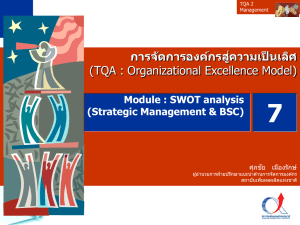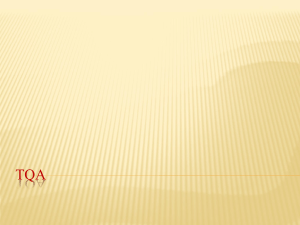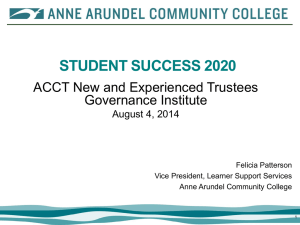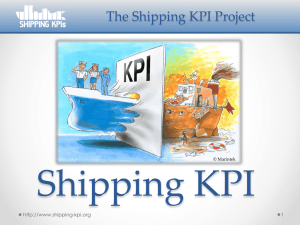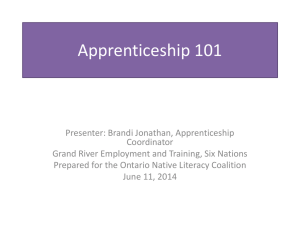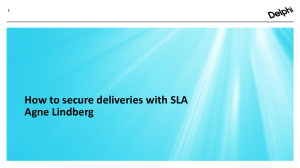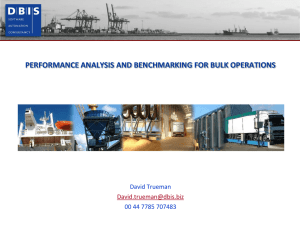Module 6: OP analysis & Business Model
advertisement
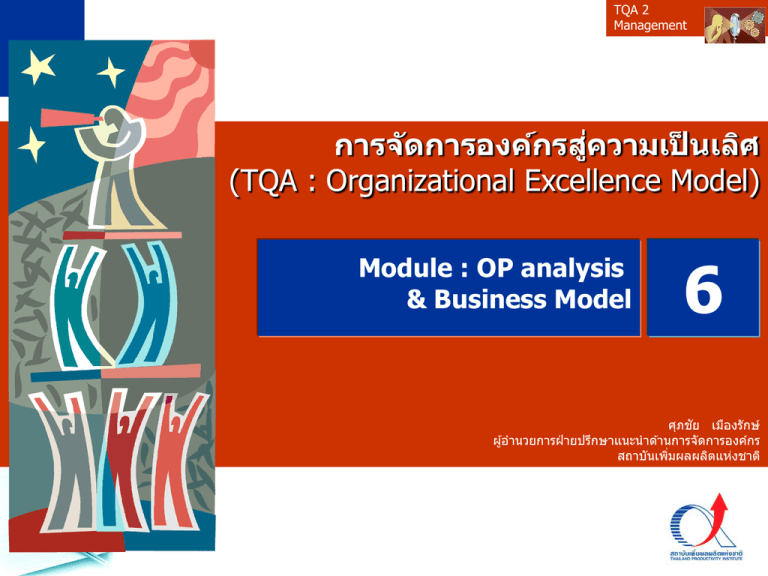
TQA 2 Management ่ วามเป็นเลิศ การจ ัดการองค์กรสูค (TQA : Organizational Excellence Model) Module : OP analysis & Business Model 6 ั ศุภชย เมืองรักษ์ ผู ้อำนวยกำรฝ่ ำยปรึกษำแนะนำด ้ำนกำรจัดกำรองค์กร สถำบันเพิม ่ ผลผลิตแห่งชำติ สถำบันเพิม ่ ผลผลิตแห่งชำติ TQA 2 Management พ ัฒนาคน Competitiveness พ ัฒนาไทย ่ ารแข่งข ันสากล สูก หัวข ้อบรรยำย 1. 2. 3. 4. TQA Concept (review) Organizational Profile Business Model Alignment Analysis TQA 2 Management Management System Design TQA 2 Management 1. Design Principles (11 Core values) 4. Path to Performance Excellence (6 Maturity level-scoring & Self assessment ) Management System Design 2. Key Organization Factors (P1-P2) 3. Organization System (Criteria 1-7) TQA : 11 Core Values 1. Design Principles (11 Core values) Good Organization • • • • • • • • • • • Directive Leadership Product/Service-Driven Meet Standards or “status quo” Suppliers and Unions as Adversaries Respond in Time Allotted Focus on Next Quarter’s Results Employees Follow Procedures Management by Intuition Compliance with Regulation Focus on $ “bottom-line” Exclusively Functional Perspective TQA 2 Management Great Organization 1. 2. 3. Visionary Leadership Customer-Focused Excellence Organizational & Personal Learning 4. Valuing Staff & Partners 5. Agility 6. Focus on the Future 7. Managing for Innovation 8. Management by Fact 9. Social Responsibility and Community Health 10. Focus on Results & Creating Value 11. Systems Perspective Organizational Excellence Model : TQA TQA 2 Management P : ล ักษณะสาค ัญขององค์กร ั ันธ์ และความท้าทาย สภาพแวดล้อม ความสมพ 2. การวางแผน เชงิ กลยุทธ์ 5. การมุง ่ เน้น ทร ัพยากรบุคคล 1. การนา องค์กร 7. ผลล ัพธ์ การดาเนินการ 3. การมุง ่ เน้น ลูกค้าและตลาด 6. การจ ัดการ กระบวนการ 4. การว ัด การวิเคราะห์ และการจ ัดการความรู ้ Lead the organization Manage the organization Improve the organization TQA 2 Management TQA : 2552 P. ลักษณะสำคัญองค์กร (โครงร่ำงองค์กร) P1. ลักษณะ องค์กร ก. สภำพแวดล ้อม ขององค์กร (1)1 ผลิตภัณฑ์และบริกำรหลัก (O) และกลไกในกำรส่งมอบ (P) ให ้ลูกค ้ำ (C) (2) 2 ทิศทำงองค์กร 2.1 วัฒนธรรม 2.2 จุดปรสงค์(เจตนำรมย์/ยุทธศำสตร์) ั ทัศน์ 2.3 วิสย 2.4 พันธกิจ (ตำม กม. / ตำมจริง) 2.5 ค่ำนิยม (3) 3ลักษณะโดยรวมของบุคลำกร 3.1 กำรจำแนกกลุม ่ ประเภท 3.2 ควำมต ้องกำรคำดหวัง 3.3 ระดับกำรศึกษำ 3.4 ควำมหลำกหลำยและภำระงำน 3.5 กลุม ่ จัดตัง้ เพือ ่ ต่อรองกับองค์กร 3.6 สิทธิประโยชน์ 3.7 ข ้อกำหนดพิเศษ(ด ้ำนสุขภำพและ ควำมปลอดภัย) (4) 4 อำคำรสถำนที่ เทคโนโลยี อุปกรณ์ และ Core Competency และ know how, งบประมำณ (5) 5 กำรดำเนินกำรภำยใต ้ สภำพแวดล ้อมด ้ำน • กฎระเบียบ • ข ้อบังคับ • กำรรับรองระบบงำน • มำตรฐำน ั พันธ์ ข. ควำมสม ระดับองค์กร (1) 6 โครงสร ้ำงองค์กรและระบบ ธรรมำภิบำล (GG) และระบบ รำยงำนระหว่ำง คณะกรรมกำร กำกับ ผู ้นำระดับสูง และกับ องค์กรแม่ (2) 7 กลุม ่ ลูกค ้ำ(C)และกลุม ่ ผู ้มี ส่วนได ้ส่วนเสีย(ST) และส่วน ตลำดทีส ่ ำคัญ • ควำมต ้องกำรคำดหวัง • ควำมแตกต่ำงระหว่ำงกลุม ่ (3) 8ประเภทผู ้ส่งมอบ (S) และ คูค ่ วำมร่วมมือ (P) ทีส ่ ำคัญ • บทบำทในระบบงำน • บทบำทในกำรสร ้ำงนวัตกรรม • ข ้อกำหนดทีส ่ ำคัญทีส ่ ด ุ (4) 9 ควำมสัมพันธ์และกลไกกำร ่ สำรระหว่ำงองค์กรกับ สือ • ผู ้ส่งมอบ (S) • คูค ่ วำมร่วมมือ (P) • ลูกค ้ำ (C) P2. ควำมท ้ำทำยต่อองค์กร ก. สภำพแวดล ้อมด ้ำน กำรแข่งขัน (1) 10 สภำพกำรแข่งขัน • จำนวนและประเภทคูแ ่ ข่ง • ผลกำรเทียบ (ลำดับ) • ขนำดและกำรเติบโต (2) 11 ปั จจัยหลักของ องค์กรทีส ่ ง่ ผลสำเร็จในกำร แข่งขัน (CSF) และกำร เปลีย ่ นแปลงทีส ่ ำคัญ (Factor) ทีส ่ ง่ ผลต่อ • สถำนะกำรแข่งขัน • โอกำสกำรสร ้ำงนวัตกรรม • โอกำสสร ้ำงควำมร่วมมือ (3) 12 แหล่งข ้อมูลเชิง เปรียบเทียบ • กลุม ่ เดียวกัน • ต่ำงกลุม ่ • ข ้อจำกัดของข ้อมูล ข. บริบท ค. ระบบกำรปรับปรุง เชงิ กลยุทธ์ ผลกำรดำเนินกำร (1) 13 ควำมท ้ำทำย (-) และควำมได ้เปรียบ (+) เชิงกลยุทธ์ • ด ้ำนธุรกิจ (พันธกิจ) • ด ้ำนปฏิบต ั ก ิ ำร • ด ้ำนบุคลำกร และควำมท ้ำทำยและ ควำมได ้เปรียบเชิงกลยุทธ์ ทีส ่ ง่ ผลต่อควำมยั่งยืนของ องค์กร (1) 14 ส่วนประกอบ สำคัญของระบบกำร ปรับปรุงผลกำร ดำเนินกำร รวมทัง้ • กำรปรับปรุง • กำรประเมินผลและ • กระบวนกำร แลกเปลีย ่ นเรียนรู ้ 2. Key Organization Factors (P1-P2) Organizational Excellence Model : TQA P : ล ักษณะสาค ัญขององค์กร TQA 2 Management 3. Organization System (Criteria 1-7) ั ันธ์ และความท้าทาย สภาพแวดล้อม ความสมพ 2. การวางแผน เชงิ กลยุทธ์ 5. การมุง ่ เน้น ทร ัพยากรบุคคล 1. การนา องค์กร 7. ผลล ัพธ์ การดาเนินการ 3. การมุง ่ เน้น ลูกค้าและตลาด 6. การจ ัดการ กระบวนการ 4. การว ัด การวิเคราะห์ และการจ ัดการความรู ้ Excellence Model 1-6,7 Criteria Assessment Organizational Profile: Environment, Relationships, and Challenges Content Management Knowledge 1 Leadership 2 Strategic Planning 5 Human Resource Focus 7 Business Results 3 Customer and Market Focus 6 Process Management (Cat.1-5 ) 4 Measurement, Analysis, and Knowledge Management 2 Result Assessment Knowledge (LeTCI) 1 PDCA Knowledge (ADLI) Process Management Knowledge (Cat.6) 4. Path to Performance Excellence (6 Maturity level-scoring & Self assessment ) TQA 2 Management Business Model : Key factors Customer Value Proposition • Offering perception • Satisfaction • Impact Outcome Key Stakeholder • Customer • Partner • Supplier • Competitor • • Other Stakeholder • • Stakeholder • • • • 1 5 4 • • • • Output & Specification Output offering Job to be done Efficiency & Effectiveness Productivity Output Key Resources 2 People, Man Technology, machine Information, need, condition, law Partnerships Method Material, Money, other resource Direction, Strategic, Work system Input 3 Key Processes • Process & Step • Metric • Requirement Process Business Model : Key factors 1 Key Stakeholder • Customer • Partner • Supplier • Competitor • Other Stakeholder Stakeholder NO. 1 2 3 4 5 TQA 2 Management ่ นได้สว ่ นเสย ี กลุม ่ ผูร้ ับบริการและผูม ้ ส ี ว (ดูจำก OP-7,8) TQA 2 Management Business Model : Key factors 2 • • • • • • • Key Resources People, Man Technology, machine Information, need, condition, law Partnerships Method Material, Money, other resource Direction, Strategic, Work system Input NO. ปัจจ ัยนาเข้า จากภายนอก (ดูจำก OP5,7,8) ข้อกาหนด สาค ัญ ปัจจ ัยนาเข้าทีม ่ ี อยูภ ่ ายใน (ดูจำก OP2,3,4,5,6) ข้อกาหนด สาค ัญ ต ัวชวี้ ัด (วัดทีก ่ ระบวนกำร) 1 2 3 NO. 1 2 3 ต ัวชวี้ ัด (วัดทีก ่ ระบวนกำร) TQA 2 Management Business Model : Key factors 3 Key Processes • Process & Step • Metric • Requirement Process NO. กระบวนการ หล ัก ข้อกาหนด สาค ัญ กระบวนการ สน ับสนุน ข้อกาหนด สาค ัญ ต ัวชวี้ ัด (วัดทีก ่ ระบวนกำร) 1 2 3 4 5 NO. 1 2 3 4 5 ต ัวชวี้ ัด (วัดทีก ่ ระบวนกำร) TQA 2 Management Business Model : Key factors 4 • • • • Output & Specification Output offering Job to be done Efficiency & Effectiveness Productivity Output NO. 1 2 3 4 5 ิ ค้าและบริการ สน (ข ้อมูล ควำมรู ้... ) คุณสมบ ัติของ บริการทีด ่ ี ต ัวชวี้ ัด Business Model : Key factors 5 Customer Value Proposition • Offering perception • Satisfaction • Impact Outcome NO. 1 2 3 4 5 ผูร้ ับบริการ (ดูจำก OP-7) TQA 2 Management ความต้องการ ของผูร้ ับบริการ ต ัวชวี้ ัด TQA 2 Management Strategic Thinking ปัจจ ัยภายนอก การ เปลีย ่ น แปลง เป้าหมาย ั ัศน์ วิสยท พ ันธกิจ • เศรษฐกิจ ั • สงคม • การเมือง • ธรรมชาติ ี • ผูม ้ ส ี ว่ นได้สว่ นเสย ปัจจ ัยภายใน Firm Infrastructure ( Fin. Plan..) Human Resource Management SUPPORT ACTIVITIES Technology Development Procurement MARGIN Inbound Logistics Operations (Manufacturing) Outbound Logistics Marketing and Sales PRIMARY ACTIVITIES After Sale Service TQA 2 Management Value Chain : SIPOC Model Supplier Input Process 1 Partners คูค ่ วามร่วมมือคือใคร ิ ค้าหรือบริการคืออะไร สน 4 ปัจจ ัยนาเข้าของกระบวนการคืออะไร 5 Suppliers Inputs Outcome ความต้องการคืออะไร Outputs Process Customers 2 3 กระบวนการทีเ่ หมาะสมคืออย่างไร 6 Customer of Customer Output Customer ิ ค้าหรือบริการคือใคร ผูร้ ับสน 7 ่ มอบปัจจ ัยคือใคร ผูส ้ ง 8 องค์กร ของเรา 9 Stakeholders อื่น TQA 2 Management Value Chain / Supply Chain Input Process Output Input Process หน่วยงำน กระทรวง อืน ่ หรือ เอกชน Input Process Output ่ นได้ ผูม ้ ส ี ว ่ นเสย ี สว พันธมิตร คูค ่ วำมร่วมมือ ผู ้สง่ มอบ ของ ผู ้สง่ มอบ Output ผู ้สง่ มอบ ผู ้เกีย ่ วข ้อง หน่วยงำน อืน ่ ผู ้รับบริกำร หรือลูกค ้ำ ลูกค ้ำของ ลูกค ้ำ หน่วยงำน หรือ เอกชน หน่วยงำน หน่วย งำนอืน ประชำชน Input Process Output TQA 2 Management External Factor Model Stakeholder PEST Model Stakeholder Model TQA 2 Management Value Chain Management Are We Doing Things Right? Are We Doing The Right Things? (How?) (What?) Process Input (Requirement) (Specification) Supplier (Need) Output (Specification) Partner (Need) Stakeholder (Need) Input : Resources, including cost and workforce Process : Activities, efforts, workflow Output : Products and services produced Outcome : Results, accomplishments, impacts Customer (Need & Outcome) KPI • lead • lag Performance Measures TQA 2 Management Value Chain Management Are We Doing Things Right? Are We Doing The Right Things? (How?) (What?) Process Input (Requirement) (Specification) (Specification) Customer (Need & Outcome) Partner Supplier (Need & Outcome) Output (Need & Outcome) Stakeholder (Need & Outcome) Other Stakeholder (Need & Outcome) Customer of customer (Need & Outcome ) Supplier of Supplier (Need & Outcome) TQA 2 Management TQA Criteria 7 2009 หมวด 7 ผลลัพธ์ 7.1 ผลลัพธ์ ด ้ำนผลิตภัณฑ์และ บริกำร 7.2 ผลลัพธ์ ด ้ำนกำรมุง่ เน ้น ลูกค ้ำ 7.3 ผลลัพธ์ ด ้ำนกำรเงินและ ตลำด ก. ผลลัพธ์ด ้ำนผลิตภัณฑ์และ บริกำร ก. ผลลัพธ์ด ้ำนกำรมุง่ เน ้น ลูกค ้ำ ก. ผลลัพธ์ด ้ำนกำรเงินและ ตลำด (69)1 ระดับปั จจุบน ั และแนวโน ้ม ของตัววัดของผลลัพธ์ด ้ำน ผลิตภัณฑ์และบริกำร (70)2 ระดับปั จจุบน ั และแนวโน ้ม ของตัววัดของผลลัพธ์ด ้ำนควำม พอใจและไม่พอใจของลูกค ้ำ (71)3 ระดับปั จจุบน ั และแนวโน ้ม ของตัววัดของผลลัพธ์ด ้ำนคุณค่ำ จำกมุมมองของลูกค ้ำ 7.4 ผลลัพธ์ ด ้ำนกำรมุง่ เน ้น บุคลำกร 7.5 ผลลัพธ์ ิ ธิผลของ ด ้ำนประสท กระบวนกำร ก. ผลลัพธ์ด ้ำนกำรมุง่ เน ้น บุคลำกร ิ ธิผล ก. ผลลัพธ์ด ้ำนประสท ของกระบวนกำร (74)6 ระดับปั จจุบน ั และแนวโน ้ม ของตัววัดของผลลัพธ์ด ้ำนกำรทำ ให ้บุคลำกรมีควำมผูกพันองค์กร (77)9 ระดับปั จจุบน ั และแนวโน ้ม ของตัววัดของผลลัพธ์ด ้ำนกำร ปฏิบต ั ก ิ ำรของระบบงำน (75)7 ระดับปั จจุบน ั และแนวโน ้ม ของตัววัดของผลลัพธ์ด ้ำนขีด ควำมสำมำรถและอัตรำกำลัง (78)10 ระดับปั จจุบน ั และแนวโน ้ม ของตัววัดของผลลัพธ์ด ้ำน กระบวนกำรทำงำน (76)8 ระดับปั จจุบน ั และแนวโน ้ม ของตัววัดของผลลัพธ์ด ้ำน บรรยำกำศกำรทำงำนของบุคลำกร (72)4 ระดับปั จจุบน ั และแนวโน ้มของ ตัววัดของผลลัพธ์ด ้ำนกำรเงิน (73)5 ระดับปั จจุบน ั และแนวโน ้มของ ตัววัดของผลลัพธ์ด ้ำนกำรตลำด 7.6 ผลลัพธ์ ด ้ำนกำรนำองค์กร ก. ผลลัพธ์ด ้ำนกำรนำองค์กร และควำมรับผิดชอบต่อสงั คม (79)11 ผลลัพธ์ของตัววัดของกำร บรรลุกลยุทธ์และแผนปฏิบต ั ก ิ ำร (80)12 ผลลัพธ์ของตัววัดของ พฤติกรรมทีม ่ จ ี ริยธรรม ธรรมำภิบำล (81)13 ระดับปั จจุบน ั และแนวโน ้มของ ตัววัดด ้ำนควำมรับผิดชอบกำรเงิน (82)14 ผลลัพธ์ของตัววัดของกำร ปฏิบต ั ต ิ ำมกฏระเบียบข ้อบังคับ (83)15 ผลลัพธ์ของตัววัดด ้ำนกำร สนับสนุนชุมชนทีส ่ ำคัญ TQA 2 Management Key Result Area & KPI 7.1 NO. KRA KPI Target KRA KPI Target 1 2 3 4 5 7.2 NO. 1 2 3 4 5 TQA 2 Management Key Result Area & KPI 7.3 NO. KRA KPI Target KRA KPI Target 1 2 3 4 5 7.4 NO. 1 2 3 4 5 TQA 2 Management Key Result Area & KPI 7.5 NO. KRA KPI Target KRA KPI Target 1 2 3 4 5 7.6 NO. 1 2 3 4 5 TQA 2 Management Key Result Area & KPI 7.1 NO. KRA KPI Target KRA KPI Target 1 2 3 4 5 7.1 NO. 1 2 3 4 5 TQA 2 Management Strategic Management MISSION VISION PROCESS Strategy A strategy should be congruent with CUSTOMER EXPECTATIONS ORGANIZATION CULTURE / CORE VALUES an organizations most important values, practices and beliefs (culture). Strategic Planning System TQA 2 Management TQA 2 Management Business Model Ontology Partner Networks Key Activities Key Resources Cost Structures Value Propositions Client Relationships Distribution Channels Revenue Flows Client Segments TQA 2 Management หลักเศรษฐกิจพอเพียง พอประมาณ มีเหตุผล มีความรู ้ มีภม ู ค ิ ม ุ ้ ก ัน มีคณ ุ ธรรม TQA 2 Management หลักเศรษฐกิจพอเพียง Efficiency input input TQA/HA/PMQA/PCA Effectiveness พอประมาณ Productivity output output output input มีเหตุผล มีความรู ้ มีภม ู ค ิ ม ุ ้ ก ัน มีคณ ุ ธรรม TQA 2 Management Thank you ฝ่ ำยปรึกษำแนะนำด ้ำนกำรจัดกำรองค์กร สถำบันเพิม ่ ผลผลิตแห่งชำติ WWW.FTPI.OR.TH Tel. 0-2619-5500 Fax. 0-2619-8092 Supachai @ ftpi.or.th
